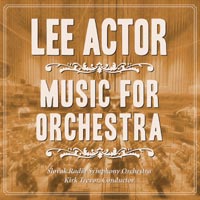
ACTOR Prelude to a Tragedy. Redwood Fanfare. Symphony No. 1. Variations and Fugue for Orchestra • Kirk Trevor, cond; Slovak RSO • MMC 2140 (57:55)
In an earlier review of this CD two issues back (29:2), John Story suggested that Lee Actor’s works offered a kind of faux-Holst “in the style of The Planets”—“the equivalent of all those fake Haydn symphonies that flooded the market in the 18th century, when there was a perceived shortage of the real thing.” I generally admire Story’s criticism, but in this case, I hear things considerably differently. Indeed, if there is anything that stands out here for me, it’s the intense seriousness of purpose behind this meticulously crafted music—if this is not the “real thing,” I don’t know what is.
Yes, like so much music written in our post-post-serialist environment, these four works are broadly conservative in character. They’re unapologetically (although far from simplistically) tonal; their rhythms are immediately engaging; and for all their interest in color, they avoid the kind of avant-garde timbral tricks that became especially popular in the wake of Penderecki’s Threnody for the Victims of Hiroshima. To put it differently, this is music that takes its inspiration from the mainstream composers of the first two-thirds of the 20th century; if you’re trying to locate it on a stylistic map, you’re more apt to choose Hindemith, Vaughan Williams, and Bernard Herrmann as points of orientation than, say, Boulez, Cage, or Xenakis. But inspiration is not quite the same as imitation, and this music is far more than a new space probe in search of undiscovered planets. Indeed, to the extent that Holst is evoked, it’s more the Holst of Egdon Heath than the Holst of “Jupiter.”
The most concentrated and powerful work here is the latest, the Prelude to a Tragedy (2003), a patiently brooding 12-minute tone poem that makes chilling use of eerie ostinatos and—even more disturbing—ambiguous rocking harmonic progressions that open up new vistas without offering any real escape from the slate-grey claustrophobic surroundings. In spirit, although not in sound, it has a certain kinship to Rachmaninoff’s Isle of the Dead: despite its thematic and formal intricacy, atmosphere—a sense of looming inevitability—is more central to the effect than traditional symphonic development. But Actor’s score is far more austere than Rachmaninoff’s, which at least has its aura of consolation. If you’re moved by the haunting nostalgia of Herrmann’s score for Vertigo or the bleak monumentality of Vaughan Williams’s Sinfonia antartica, you’ll want to know Prelude to a Tragedy.
The slightly earlier First Symphony is less monolithic, but ultimately similar in spirit. It’s a formally tight work, both in terms of its overall architecture (the first movement, for instance, is quite audibly in sonata form) and in terms of the intricate interconnections among the fundamental thematic and motivic materials. Still, as in the Prelude to a Tragedy, the work’s power lies even more in its atmosphere than in its structural ingenuity. And that atmosphere tends toward the dark—not only in the ominous central Lament (built on the opposition of a harmonically ambiguous chorale and a series of longer melodic spans) but in the superficially brighter outer movements as well. Thus, the first movement, for all its optimistic rhythmic snap, for all its nimble polyphonic activity, has—to my ears—its affective center in its second theme, which raises doubts that come, in the quiet coda, to dominate the landscape. Even the more consistently upbeat finale—a prismatic spurt of marches, chorales, and interrupted fugues—returns, at the end, to the Symphony’s earlier uncertainties. Steven Ledbetter, in his detailed notes, insists that the “doubts and tensions” are ultimately “dispelled . . . with an air of triumph”—but I find the music less unambiguously optimistic than he does. Either way, though, this is a serious score that pulls you through a great deal of difficult emotional terrain.
The Redwood Fanfare, not surprisingly, is a bit showier—but even here, Actor plays with traditional gestures in a challenging way. As for the Variations and Fugue: it turns out to be a substantial closer to the disc. It starts out not with a traditional “theme” but rather with a set of ideas (what Ledbetter aptly calls an “inchoate . . . collection of melodic intervals and harmonic and rhythmic materials”) that serve as the basic ingredients of the four very different meditations that follow. The Fugue brings still further transformation of this original material along with something simultaneously new and thematically fitting: in an homage to a long tradition, the Fugue (which may remind you, in its slightly severe glory, of Hindemith’s Concert Music for Strings and Brass) eventually takes on the oft-used B-A-C-H theme. There’s a wide variety of mood here; but it’s held together not only by its formal processes but also by a gravity of intention that gives the work a strong, and slightly disturbing, expressive pull. All in all, the disc offers a portrait of a composer with a consistent voice and a sure-fire dramatic sense.
The performances, as Story noted, are excellent. The Slovak Radio Symphony Orchestra often sounds tired and uncommitted on other recordings, but Trevor has galvanized them to the point where they sound almost like a first-class outfit. Sound is impressive as well. All in all, highly recommended for those not allergic to the basic aesthetic premises. Peter J. Rabinowitz